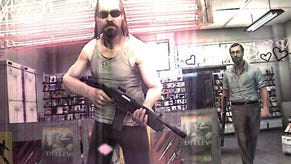Kane & Lynch 2 targets 60FPS
Full analysis of limited release 360 demo.
There seems to be a certain formula for a great many third-person shooters in this console generation: target 30FPS, slip out of v-sync if you need to, perhaps use Unreal Engine 3. Square-Enix's Kane & Lynch 2: Dog Days immediately makes an impact because it breaks away from that recipe. IO Interactive has targeted 60FPS, making for far more responsive controls and more arcade-like visuals.
IO has also opted for a very specific visual style inspired by reality documentary makers and on-the-spot video filming. There's a very strong grain filter added to the framebuffer, along with harsh lighting and contrast and a generous dollop of camera-shake, which perhaps becomes a bit too jarring when Lynch is running along at full-pelt. A pretty cool dynamic depth-of-field effect is in place, while damage is signified by the inclusion of macroblocking and artifacting, again calling to mind mobile video footage.
So, how well does Kane & Lynch 2 maintain its high performance level?
In internal scenes, and outdoor environments where long view distances are occluded, 60FPS is sustained fairly well, with just the odd dip signified by cascading screen tear. On the street scenes, frame-rate can dip very significantly. There's a section where a shop blows up that sees performance dip to around 10FPS: is this some kind of bug, or another homage to the "on the hoof" camera style?
The move to 60FPS inevitably leads to some compromise. Similar to Infinity Ward's Call of Duty engine, the move to the fastest-possible frame-rate incurs a drop to resolution: 1024x576 or something very close to it in this case. 2x multi-sampling anti-aliasing is in, meaning that the framebuffer sits nice and snugly within the Xbox 360's 10MB of eDRAM - the memory directly connected to the graphics chip with stupidly large amounts of bandwidth - so it will be intriguing to see how the PS3 version compares.
Similar to Splinter Cell: Conviction and Alan Wake, Kane & Lynch 2's image quality manages to belie its relatively modest resolution. Art and lighting styles seem to be tailored to the amount of pixels available, and big gotchas like specular (shiny) aliasing are very limited. Post-processing, choice of colour scheme and anti-aliasing combine to ensure that harsh edge-aliasing simply isn't an issue based on what we've seen so far.
Overall impressions from this Xbox 360 demo are positive from a technical perspective and in terms of gameplay it's clear to see that the move to 60FPS offers big advantages to a shooting title. There are some concerns about AI (running around in a crowded street armed with a rifle doesn't seem to arouse much panic) and there does seem to be some inconsistency in which trouser-height barriers you're able to jump over.
Also, the omission of the split-screen mode from the demo is a bit of a disappointment. It will be interesting to see if that max 60FPS is maintained when dealing with dual-player gameplay, which we should be able to do in the retail release on 27th August. Look out for our review around that time.



